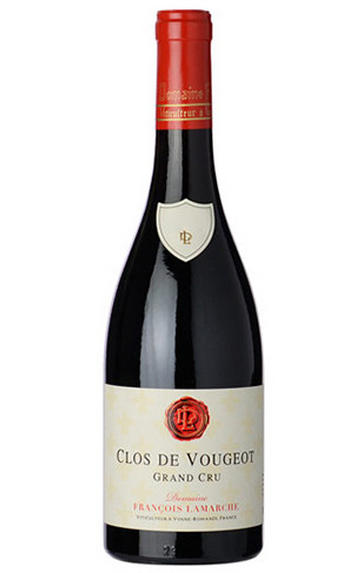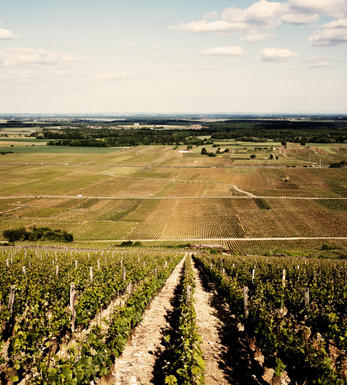
2010 Clos de Vougeot, Grand Cru, Domaine François Lamarche, Burgundy

About this WINE

Domaine Nicole Lamarche
The division of vineyards with Nicole's cousin Natalie is now complete, and Nicole now has under seven hectares, down from 11 hectares. The Malconsorts and Grands Echezeaux have gone but the monopole of La Grande Rue remains. Nicole Lamarche took over from her father, François, in 2006; from ’19, the domaine now carries her name.
Nicole’s style is one of a light touch; the wines aren’t deeply coloured and are sensually soft yet show wonderful intensity.
In the vineyard
Under her aegis, the vineyards have been converted to organic and biodynamic production, although certification isn’t sought. The vines are now trained higher, and leaf cover is retained. In the cellar, the barrel regime has been changed, both in the lower proportion of new oak used each year, and in the coopers that supply the barrels
In the winery
When asked for details of the winemaking process, Nicole remains steadfastly enigmatic: there’s no formula and every cuvée receives a customised élevage. However, there’s always a proportion of whole bunch on the top wines, usually around 30%.

Vougeot
Most of the wine produced in this small village comes from a single, walled Grand Cru vineyard, the famous Clos de Vougeot. The vineyard in its present form dates from 1336 (when it was first planted by monks of Cîteaux), although it was not until the following century that it was entirely enclosed by stone walls.
Clos de Vougeot is both the smallest commune and the largest Clos in the Cote d’Or. It consists of 50 hectares of vineyards shared among 82 owners, with six soil types. There is quite a difference in quality between the upper (best) and lower (least fine) parts of the vineyard, though in medieval times a blend from all sectors was considered optimum.Le Domaine de la Vougeraie makes a very fine white wine from Le Clos Blanc de Vougeot, first picked out by the monks of Cîteaux as being suitable ground for white grapes in the year 1110.
- Five hectares of village Vougeot
- 12 hectares of Premier Cru vineyards (four in all): Les Cras, Les Petits-Vougeots, Clos de la Perrière and Clos Blanc de Vougeot
- 51 hectares of Grand Cru vineyard – Clos de Vougeot
- Recommended producers: Domaine de la Vougeraie, Domaine Bertagna, Engel, Anne Gros, Grivot, Liger-Belair, Meo-Camuzet.

Pinot Noir
Pinot Noir is probably the most frustrating, and at times infuriating, wine grape in the world. However when it is successful, it can produce some of the most sublime wines known to man. This thin-skinned grape which grows in small, tight bunches performs well on well-drained, deepish limestone based subsoils as are found on Burgundy's Côte d'Or.
Pinot Noir is more susceptible than other varieties to over cropping - concentration and varietal character disappear rapidly if yields are excessive and yields as little as 25hl/ha are the norm for some climats of the Côte d`Or.
Because of the thinness of the skins, Pinot Noir wines are lighter in colour, body and tannins. However the best wines have grip, complexity and an intensity of fruit seldom found in wine from other grapes. Young Pinot Noir can smell almost sweet, redolent with freshly crushed raspberries, cherries and redcurrants. When mature, the best wines develop a sensuous, silky mouth feel with the fruit flavours deepening and gamey "sous-bois" nuances emerging.
The best examples are still found in Burgundy, although Pinot Noir`s key role in Champagne should not be forgotten. It is grown throughout the world with notable success in the Carneros and Russian River Valley districts of California, and the Martinborough and Central Otago regions of New Zealand.


Buying options
Add to wishlist
Description
Fresh fruit comes to the fore on the nose here, with power evident at both the front and back of the palate that builds towards an excellent finish. Understated, but very fine this is a great example of Clos de Vougeot.
Jasper Morris MW, Burgundy Director
With Nicole Lamarche firmly in charge, the domaine has converted to organic farming, and the recipe in the cellar this year was for a long vinification but less extraction. The wines have spent twelve months in barrel (with 30% new wood for the village wine and up to 60% for Grand Crus) before being transferred to vat. Sadly, many of the Vosne-Romane vines here did not make it through the winter, so there is no village wine this year for us in 2010. Otherwise, expect attractive wines in 2010 with excellent typicity.
wine at a glance
Delivery and quality guarantee